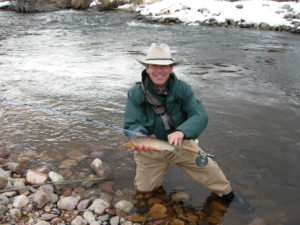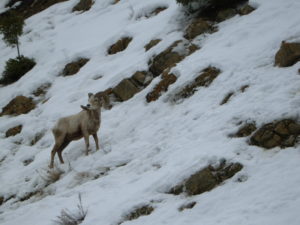Anyone who knows me, knows “cold” does not keep me from fishing. Most, if not all small streams and creeks, will freeze from bank to bank. Especially, with the type of winter Montana has had this season. It does not take many days of warmer temps and longer daylight hours to open those pieces of water. Depending on where you are fishing in this spectacular state, be aware of small stream closures. Just because the H2O has gone from “hard” to flowing, does not make it legal. Check the FWP regulations. Keep in mind you must have a new fishing license as of March 1st each year.
Depending on where you are fishing in this spectacular state, be aware of small stream closures. Just because the H2O has gone from “hard” to flowing, does not make it legal. Check the FWP regulations. Keep in mind you must have a new fishing license as of March 1st each year.
I guided for more than a decade in Colorado and down there most fly fishing is done in waders. Smaller water. From high mountain lakes with beautiful slivers of water running out to lower altitude streams, I found that type of angling quite satisfying. No boat or raft needed. Here in Montana a drift boat or raft is common and almost necessary. Floating The Missouri, The Madison, The Bighorn, The Bitterroot just to mention a few big rivers I completely enjoy. However, my passion is still seeking out those small creeks and streams. The bends, the sounds, the newness around each corner. Reading that smaller water is fun, sometimes tricky and often surprising. Wading around can also be a challenge. Negotiating “snot-slick” bowling balls topped with left over ice will test your upright skills. Heavy socks and layers of fleece beneath your waders will help. Occasionally, step out to warm those ice blocks that were once your feet. Take a little warm-up stroll. Go back to the truck for a thermos of hot soup.  My fishing partner suggests hand warmers in both boots & inside the mitten-glove for “toasty” warm. She enjoys our adventures far more while catching, instead of warming in the truck. Try a new spot. Those winter fish use many different “hides”. Toss a streamer or nymph in water you may never look at in warmer months. Fish slow, fish deep. Be patient. A person needs to put flies dang-near in the fishes face. They are hungry, but will not move far to gather food. Keep an eye out for a rise. Often fish will take a dry, even though there is no hatch. I always wear carbide spikes or aluminum plates on my wading boots (except in a boat or raft). They will help you not only in the stream, but also keep you from taking a skating lesson on the shore ice or flooded out edges. Another “always” for me and you should be a wading belt. Never, ever enter the water in waders without that belt uncomfortabley snug, no matter how small the stream. I have been on a rescue with a person “full-up” and going down for the last time. Shorter, 6Ft. to 8Ft. rods from 2-4 weight lines are waaaaay more fun. A few years ago I built a sky blue fiberglass stick I am just crazy about. No matter the size of fish, they all feel like giants and the bigger ones put a serious bend in that “jelly-stick”.
My fishing partner suggests hand warmers in both boots & inside the mitten-glove for “toasty” warm. She enjoys our adventures far more while catching, instead of warming in the truck. Try a new spot. Those winter fish use many different “hides”. Toss a streamer or nymph in water you may never look at in warmer months. Fish slow, fish deep. Be patient. A person needs to put flies dang-near in the fishes face. They are hungry, but will not move far to gather food. Keep an eye out for a rise. Often fish will take a dry, even though there is no hatch. I always wear carbide spikes or aluminum plates on my wading boots (except in a boat or raft). They will help you not only in the stream, but also keep you from taking a skating lesson on the shore ice or flooded out edges. Another “always” for me and you should be a wading belt. Never, ever enter the water in waders without that belt uncomfortabley snug, no matter how small the stream. I have been on a rescue with a person “full-up” and going down for the last time. Shorter, 6Ft. to 8Ft. rods from 2-4 weight lines are waaaaay more fun. A few years ago I built a sky blue fiberglass stick I am just crazy about. No matter the size of fish, they all feel like giants and the bigger ones put a serious bend in that “jelly-stick”.
Another wonderful feature about small stream early season fishing, are the “critters” and their tracks to be seen. Very few people, thus less noise and congestion will offer sights you will never get during the tourist invasion. Take enough time to look around. Don’t just focus on water and fish.  You can see from one of these photos there is soooooo much more out there. I do carry some type of protection (whatever you are comfortable with) on most creek adventures. I have run into moose, grizz, black bear, mountain lion, bison and the oh-so dangerous beaver & muskrat while sneaking around in search of fresh water. Don’t wait till the mercury hits 50’s 60’s & 70’s to dust off that trout rod. NOW has many advantages. Call or stop in the shop and I am happy to share much more with you.
You can see from one of these photos there is soooooo much more out there. I do carry some type of protection (whatever you are comfortable with) on most creek adventures. I have run into moose, grizz, black bear, mountain lion, bison and the oh-so dangerous beaver & muskrat while sneaking around in search of fresh water. Don’t wait till the mercury hits 50’s 60’s & 70’s to dust off that trout rod. NOW has many advantages. Call or stop in the shop and I am happy to share much more with you.
JIM STEIN………..Director Of Schools
p.s. getting in on an early season 3day fishing school (I teach) it will separate you from most out there.
